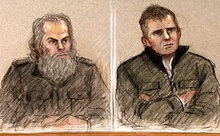
There is growing concern that the trial of two men for the Real IRA attack on Massareene British Army base two years ago, currently underway, could result in a major miscarriage of justice.
After eight days of court hearings, Crown prosecutors have gone to extreme and unprecedented lengths to link republican ‘dissident’ Colin Duffy and Tyrone man Brian Shivers to the alleged getaway car used in the attack.
In March 2009, two British soldiers were killed in the deadliest attack by the breakaway IRA groups in recent years.
Traces of DNA presented as evidence before the court this week are infinitessimally small -- one government forensic scientist admitted the sample consisted of “zero” DNA. The weight of the sample is about a 100 billion times smaller than a gram.
However, Crown prosecutors have presented the juryless court with American ‘expert’ Mark Perlin, who said he had linked Duffy and Shivers to the sample through his own unique testing method.
Perlin’s computer-based method of analysing genetic samples is new and has never once been admitted as evidence in a British or Irish court.
Defence lawyer Patrick O’Connor claimed Perlin was so focused on his “mission” to get his own forensic method accepted within the scientific community that he lacked the objectivity to acknowledge its reliability was not proven.
Mr O’Connor warned that Perlin may be prepared to exaggerate and tell partial truths in order to promote and sell his unique testing technique. The court heard that he was a 90% stakeholder in the company that operates the ‘True Allele’ ultra-low-copy DNA testing system.
On the eighth day of the trial at Antrim Crown Court, the US scientist admitted that he may have employed ‘dramatic touches’ when describing his method to lay audiences.
Mr O’Connor argued that Perlin was exaggerating the merits of his own, unvalidated system at the expense of others, and pointed out that in the one case he was previously involved with in England his evidence had been ruled inadmissable.
The defence barrister also added that Perlin had conducted his tests on the basis of there being two DNA traces within one sample, when another forensic scientist had stated that there might have been three or more.
APPEARANCES AND DISAPPEARANCES
There was also significant doubt about the provenance of the alleged DNA samples, as well as the manner in which an abandoned, partially burnt-out vehicle found after the attack was recovered and examined.
A PSNI vehicle recovery operator was found to have left DNA on the handbrake of the car, despite making a statement to police that he had never been inside the vehicle.
And there were gasps in the courtroom when it emerged that a forensic statement that a latex glove tip was found in the getaway car was only made last week. The glove tip is considered the key piece of evidence against Mr Duffy.
A forensic officer who originally examined the car only declared in the days before the trial that she had seen a glove tip -- two and a half years after the event. She explained: “I didn’t think it was relevant.”
A bomb squad officer said he did not see the piece of glove.
Barry MacDonald QC also questioned the lack of photographic evidence of the glove tip, despite over 30 photographs having been taken of other items discovered inside the vehicle.
“There is no photographic evidence to confirm this latex glove was there at all on this first day,” he said.
One photograph showed a bar code tag resting on a disc holder located in the front passenger footwell of the vehicle. However, photographs taken at a later date and shown to the court, showed the glove tip had somehow appeared next to the disc holder, and the bar code tag had clearly moved position.
In other evidence, a British soldier who was injured in the attack, Mark Fitzpatrick, estimated that those involved were in the attack were in their late twenties or early thirties -- about 15 years younger than either Mr Duffy or Mr Shivers.
And an audio clip was also played of a voice message said to have been accidentally left on a mobile phone in the car -- but the voice clip matched neither man.
For two decades Colin Duffy has been the target of an unrelenting campaign of persecution and victimisation by state forces within the Six Counties.
That campaign has encompassed the full spectrum of harassment experienced by nationalists in the Six Counties, from petty stop-and-search harassment to arbitrary arrest and detention, from verbal and physical abuse to collusion and the use of murder.
For further information on the ongoing trial, see https://friendsofcolinduffy.com
![[Irish Republican News]](https://republican-news.org/graphics/title_gifs/rn.gif)
![[Irish Republican News]](https://republican-news.org/graphics/title_gifs/harp.gif)

